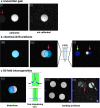How to 19F MRI: applications, technique, and getting started
- PMID: 37953866
- PMCID: PMC10636348
- DOI: 10.1259/bjro.20230019
How to 19F MRI: applications, technique, and getting started
Abstract
Magnetic resonance imaging (MRI) plays a significant role in the routine imaging workflow, providing both anatomical and functional information. 19F MRI is an evolving imaging modality where instead of 1H, 19F nuclei are excited. As the signal from endogenous 19F in the body is negligible, exogenous 19F signals obtained by 19F radiofrequency coils are exceptionally specific. Highly fluorinated agents targeting particular biological processes (i.e., the presence of immune cells) have been visualised using 19F MRI, highlighting its potential for non-invasive and longitudinal molecular imaging. This article aims to provide both a broad overview of the various applications of 19F MRI, with cancer imaging as a focus, as well as a practical guide to 19F imaging. We will discuss the essential elements of a 19F system and address common pitfalls during acquisition. Last but not least, we will highlight future perspectives that will enhance the role of this modality. While not an exhaustive exploration of all 19F literature, we endeavour to encapsulate the broad themes of the field and introduce the world of 19F molecular imaging to newcomers. 19F MRI bridges several domains, imaging, physics, chemistry, and biology, necessitating multidisciplinary teams to be able to harness this technology effectively. As further technical developments allow for greater sensitivity, we envision that 19F MRI can help unlock insight into biological processes non-invasively and longitudinally.
© 2023 The Authors. Published by the British Institute of Radiology.
Conflict of interest statement
Competing interests: MD and MS work for Cenya Imaging BV.
Figures



References
-
- Bassir A, Raynor WY, Park PSU, Werner TJ, Alavi A, Revheim ME. Molecular imaging in atherosclerosis. Clin Transl Imaging 2022; 10: 259–72. doi: 10.1007/s40336-022-00483-y - DOI
Publication types
LinkOut - more resources
Full Text Sources
Research Materials

